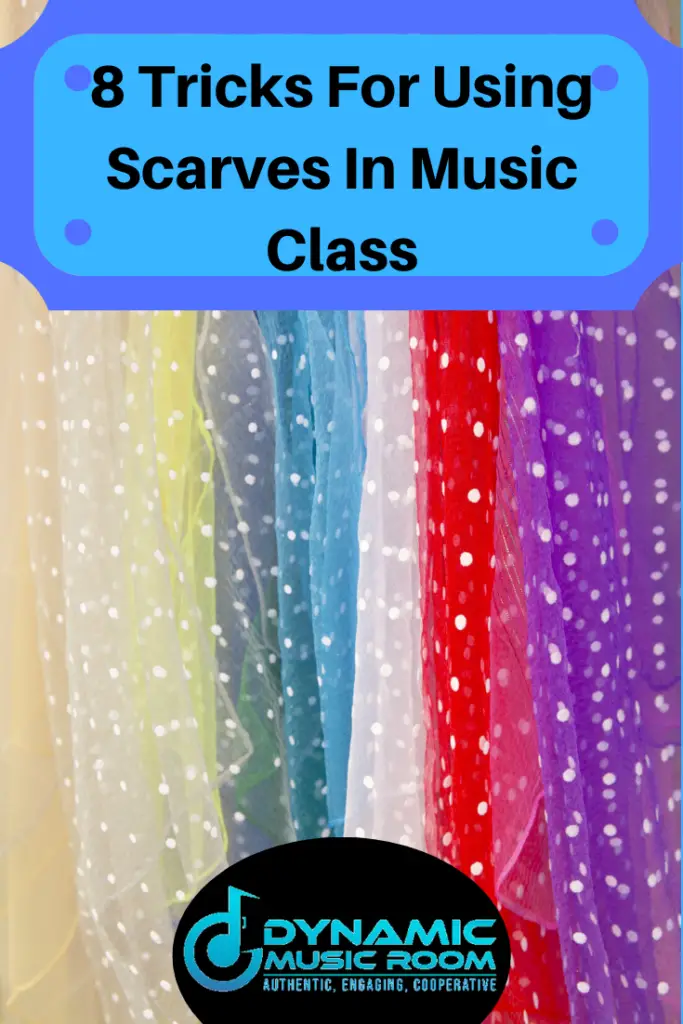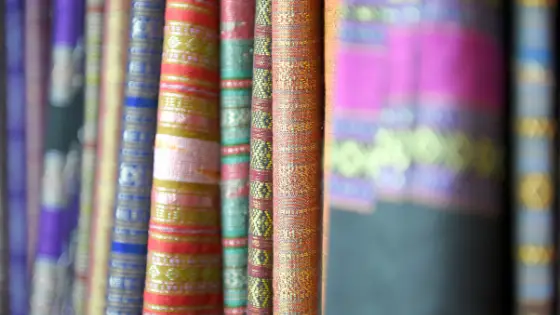Do you want to include more movement in your classroom?
Are you looking for a powerful movement prop to get kids out of their heads and into their bodies?
Scarves are a fun way to augment creative movement in your lessons, but there are some tricks to using scarves in music class.
Using scarves in music class will improve a student’s expressive movement qualities if you set up procedures correctly, use engaging activities, find good music to move to, and plan the lesson out.
Look ahead for a break down to help you through using scarves for creative movement.

Save time with these 60 FREE Music Resources to use in your room right away!
Stop searching the whole internet to find good activities. I’ll help you cut to the chase with my favorite 60 FREE resources.
Table of Contents
8 Tricks For Dancing With Scarves
If you’ve ever tried handing out scarves to your students without any general plan or procedures, it probably didn’t go well.
I did the same thing, and the result was so disastrous I swore off ever using them again.
But my host teacher when I student taught (back in the day) coached me through some of my mistakes and shared some tricks.
Here are the tricks I learned from him and other teachers since.
#1 Set Procedures Early
Setting procedures and rules for movement and scarves right from the get-go is essential in having a good movement experience.
Without it, the situation will quickly devolve into mass chaos!
Before I ever let my students use scarves or move freely, I review basic expectations for the activity beforehand.
I do this every time we do movement.
The first time, I go into more detail on the procedures and stop the activity more often to offer feedback, positive reinforcement, and redirection.
Reviewing the procedures doesn’t have to take a lot of time.
I usually make my students echo the rules for any activity back to me before we play.
Here is what I have them echo for creative movement:
- I promise
- To move with purpose
- With my hands to myself
- Keeping my voice silent
- I may feel silly
- And that’s OK
- I will show the feeling of the music.
Note: If you wanted to, facilitating students in the generation of their own rules and expectations is another great idea. It just takes more time.
For movement with scarves, I use the following echoing rules:
- I promise
- To keep the scarf away from my face and the faces of my friends
- To hold on to the scarf unless it’s a special ending
- I’ll use the scarf as a way to show the movement of the music
- To treat the scarf with respect
- Or I lose my turn
- And at the end
- I will pack it away like Mr. V says.
Note: Some teachers are really picky about folding their scarves in half, then quarters, and then putting it away.
Maybe I’m weird, but I usually just ask students to fold them twice and take what they give.
The folds usually give out as soon I move the scarves anyway.
#2 Follow The Modeling Steps
Whenever I start any new activity, but especially movement with props, I always go through the modeling steps.
And if the class isn’t following the directions correctly, I back up to the beginning again.
Here are the steps for modeling a new activity:
- Briefly explain the activity
- Model it yourself
- Select 1-3 students to model
- Select 5-7 students to model
- Let the whole class try the activity
- Play the activity
Note: During this whole process, be sure to praise those who follow the procedures and specifically call out behaviors that match what you want.
#3 Use Tossing The Scarves As A Reward At The End
One of the most fun things to do with scarves is to toss them into the air let students catch them or watch them fall to the ground.
But it’s also one of the most distracting and off-tasks uses for the scarves if students abuse this too much.
I prefer to hold back tossing the scarves except at the very end of the movement. This way, the move still feels special, and you can use the tossing as a reward for the good behavior you’re looking for.
#4 Mirror Movement
In the beginning, when you use scarves, students won’t have a movement “vocabulary” to pull from to create their own moves.
Some students will be naturally expressive in their movements, but most kids will just halfheartedly shake them around while walking.
You need to provide students with experience in moving with the scarves before they can branch out easily on their own.
One of the most effective ways to do this is with Mirror Movements.
Students stand in one spot and match your movements like a mirror.
In this way, you move matching the feeling of the music and give them the moves they may wish to use when they create moves on their own later.

#5 Give Them Boundaries
As any good jazzer will tell you, students first need to understand the rules and boundaries before they can break them.
Sure, you could tell students to just move how the music feels, but you’ll most likely end up with randomness and very little intentional expression.
Give students a boundary or limitation on their movement, and you’ll find the students will be so focused on how to push the limits they’ll be more creative.
Here are a couple of examples of boundaries you may wish to try:
- Tell students they are inside a bubble and must mark the edges of the bubble with their scarves while they move.
- Tell students their elbows must be the first body part to move and lead their movements.
- Students must pick one level (high, middle, low) and stick to movement in that level until you either tell them to switch or play a sound cue such as a triangle.
- Students must balance the scarf on their elbow or shoulder as they move.
#6 Use Imagery
Not all students are naturally expressive movers, but each and every one of them has the potential.
To help develop the moving skills with scarves, you may want to differentiate your instruction by accessing other intelligences.
But we already have them moving and listening. What’s missing? you may wonder.
Well, the visual intelligence can be easily integrated with such movement activities like a creative scarf movement.
Two ways I go about including visual prompts are:
- Showing a picture or piece of art to inspire the kids.
- Asking them to imagine something and to draw this out with the scarf while they move.
When showing art, I have to rely on the expertise of others. So I either talk to my art teacher, or I’ve also looked for resources such as this Art Class Curator article of 52 pieces of art.
For imagination prompts, here are a few I’ve used before:
- Your scarf is a bumblebee fluttering from flower to flower
- The scarf is a raft on a rapidly flowing river
- Your scarf is smoke rising of a campfire in a gentle wind
- Your scarves are crickets hopping around the forest floor
- The scarf is the wind blowing in as a powerful storm approaches
Pro-tip: Make sure the image matches the style of music you’re going to play.
#7 Reward Good Behavior
It may seem pretty obvious, but reinforcing appropriate behavior is important during this process.
For one, it helps motivate the kids to participate. It also helps students feel safe enough to be creative.
And finally, praising the behavior you want also helps students understand what good creative movement includes.
This only works if you offer specific reinforcement based on what the students are doing.
If you just tell students “Hey, that was good! Nice job!”, they won’t improve.
Instead, tell them exactly what you liked. Here are some examples:
“I love how Jenna moved slow and gently. It really matched the music.”
“Did you see how Billy did this whole movement section without making a single sound? Way to go, bud!”
“Dave, I saw you used high, middle, and low levels when moving. That was awesome!”
“Carrie, I noticed you moved faster and slow when the music did. Nice listening!”
#8 Do The Movement Without Props First
This is one trick I always forgot to do, and it paid me back harshly.
As soon as you give kids (or adults) scarves, they immediately focus on the prop rather than the movement and music.
You should always practice the activities without the scarves first. This way, students focus on the movement and the music without being distracted.
After kids show you what you want, then you may begin to add scarves for help moving.
Scarf Dancing Resources
Now that we have some tricks for using scarves with movement, we need some resources.
Here is a list of some of my favorite scarf and movement resources. Be sure to click the link for current pricing (I’ve gotten a few of them on sale from Amazon over the years).
Dance Scarves Music Scarves – These scarves by AIVAI are durable, light, and affordable. These are the ones I use when I need to buy them.
It comes in a 12 pack, so you may have to buy 3 or 4 to cover your needs for a while.
Parachutes, Ribbons, and Scarves, Oh My! – These listening legends by respected movement teacher Artie Almeida are great for scarves and other movement activities besides.
Kimbo Educational Musical Scarves And Activities CD – This set of activities is more for younger kids, but starting with structured movement earlier will help with creative movement later.
Move It! Expressive Movements With Classical Music – This collection of movement activities is great. I’ve used this for years now.
Although the movements weren’t made with scarves in mind, adding them is simple.
Conclusion
I hope you found this info on using scarves in music class helpful. With these tricks, don’t feel so scared about giving them a shot.

Save time with these 60 FREE Music Resources to use in your room right away!
Stop searching the whole internet to find good activities. I’ll help you cut to the chase with my favorite 60 FREE resources.

